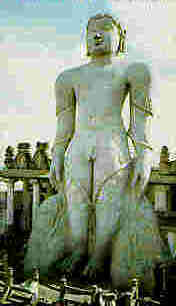
Shravanabelagola in Karnataka.
This shirne belongs to the
Digambara sects of the Jains.
|
_____________________________________________________________
_________________________________________________
Popularly, Mahavira who was the last Jaina Tirthankara is confounded to be the founder of this faith.
 | A towering statue of Bahubali at Shravanabelagola in Karnataka. This shirne belongs to the Digambara sects of the Jains. |
But as per Jaina records, 23 Tirthankaras preceded him. He was only the last and incidentally the most famous Tirthankara.
Jainism like Buddhism arose us a protest against the ritualism of the Hindu religion. It's origin is traced to Vedic times. The first Jaina Tirthankara was Rishabha. After his appearance, 23 Tirthankaras made their appearance at successive intervals of decreasing length of time. Details about their lives are given in the Jaina treatise Kalpa-Sutra. The 23rd Tirthankara was Parshwanath who though not as famous as Mahavira is still widely remembered among the Jains. Parshwanath is said to have lived 250 years before Mahavira.
The Life Story of Mahavira
Mahavira lived in the 6th century B.C.E. and was a contemporary of Gautama Buddha. There are close parallels not only the teaching of Buddha and Mahavira but also in the story of their lives. Mahavira, like Gautama Buddha was born in a kshatriya family. His father whose name incidentally was Siddhartha, belonged to the Kashyapa clan and was ruler of Kundagrama located near the powerful kingdom of Vaishali, Mahavira's mother Trishala was the sister of the reigning king of Vaishali. That Mahavira himself is referred to at times as Vaishilika is an evident proof of Mahavira's close connection with this powerful kingdom located in eastern India.
According to Jaina legend, Mahavira was to be borne by a Brahmin woman but his embryo was transferred to that of a Kshatriya woman, for it was impossible for a person so great to be born "in low families, mean families, degraded families, beggar's families or Brahmin families". This statement in the Kalpa-Sutra is an indication of ill-feeling that existed in ancient times between the practitioners of Vedic rituals and the Jainas.
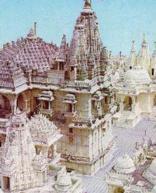 | Jain Temples at Palitana |
The name given to Mahavira at birth was Vardhamana or 'increaser'. But later on he acquired fame as Mahavira or the 'Great Hero' which we are told was a name bestowed to him by the Gods. When he was thirty years old his parents died and in fulfillment of a promise, he decided to renounce material pleasures and meditate in solitude Like the Buddha, he subjected himself to severe penances, he had stripped himself naked observed fast and neglected his body. After revelation he spread his gospel among the people. At his death his following was considerable.
Similarities and Differences with Buddhism
Unlike Buddhism, the Jaina faith does not seem to have received considerable royal patronage in Northern India. The only great pan-Indian monarch said to have embraced Jainism was Chandragupta Maurya and he seems to have embraced it at the end of his reign. On embracing Jainism he is said to have renounced his throne in favour of his son Bindusara and migrated to the Jain spiritual centre at Shranvanabelgola in Karnataka (South India). In South India though, many local kings did give generous grants to Jains to build beautiful temples and monoliths of Bahubali. At Khajuraho in central India, the Chandellas in the 10th century did build some temples dedicated to Parshwanath. But despite the absence of considerable royal patronage, Jainism has kept itself alive through the ages although its following has always been a modest one. Unlike Buddhism, Jainism has remained limited to India and never spread overseas. In India also its followers are concentrated in North Gujarat, South Rajasthan, around Agra region in Uttar Pradesh and Sammed Shikhar in North India. Jains are also found in parts of Karnataka in the South.
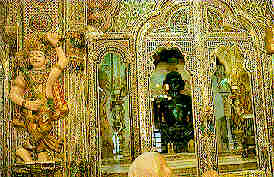 | The Sanctum of a Jain Derasar at Indore The intricate mirrowork has to be seen to be believed. |
Two Sects - Shwetambara and Digambara
The followers of Jainism are divided into two sects, viz., the Digambars or 'sky-clad' who theoretically accept the principle of a living person being shorn of garments. The second sect is that of the Shwetambars who clothe themselves with unstitched white cloth. The Shwetambars split from the main body of the Jaina religion some 200 years after Mahavira but today they account for a majority among the Jains. The Shwetambar Jains are concentrated in Gujarat and Rajasthan. The Digambars are mostly found in Karnataka.
The Central Principal of Jivadaya - Respect for all Living Forms
The principle that is central to the Jaina religion is that of Jivadaya (Respect for all Living Forms) and Ahimsa (non-violence). Although Ahimsa is recognised even by the Buddhists and the Hindus, it is practised ritually, only amongst the Jains. Under this obligation they abstain entirely from meat, fruit and wine and may drink only that water which has been used earlier by someone else for cooking. The logic behind this is that if by drinking such water if a Jain causes harm to any living organisms in the water, the guilt for that rests not on the Jain who drinks it but on the person who first used it for cooking. For the same reason a Jain monk does not bathe lest he should inadvertently destroy life, nor is he allowed to move about except on foot, he is prohibited from lighting a fire or to breath openly for which a piece of white cloth is tied loosely around his mouth so as to prevent the inadvertent killing of living organisms in the air by inhaling them. All this would appear ridiculous to a non-Jain or even to a modern-day Jain.
Despite these strictures against harming or killing any living creature, remarkably this logic is not applied by the Jains to themselves.
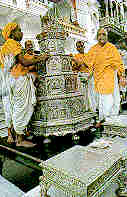 | A Jain Religious Ceremony being performed at a Derasar around a Silver pedestal. The Jains use Silver very generously. During the procession taken out during the celebrations of the Jain Samvatsari (New Year) a silver rath (carriage) is invariably used to carry the idols of Mahavir and other Tirthankaras. |
When certain conditions have been fulfilled, a Jain ascetic may undertake Samadhi (defined in theological literature as a state of 'Super-consciousness' and is considered by lay people to be a suicide for religious reasons). This act is not only innocent, but is an act of merit or even a duty. The concept of Samadhi is not peculiar among the Jains. It exists amongst the Hindus too.
An Order of Jaina Monks (Munis) and Nuns (Sadhvis)
Like the Buddhists, the Jains have an order of Monks. In addition to Monks, the Shwetambars also have an order of Nuns called Sadhvis. In addition to the alms bowl, a Jain monk is supposed to carry a broom to sweep the ground before them as they walk on it so as to clear away whatever living creatures that may be there. The institution of monks no doubt is derived from the Hindu concept of Sanyasa. During the four months (Chatur-masa) of the monsoon, a Jaina monk is required to stay indoors so as to avoid treading on the many creatures that run around during the rains. This observance, during the four months of the monsoon is shared by the Jains with the Buddhists and is perhaps derived from the Hindu concept of Chatur-masa during which indoor spiritual activity is recommended probably due to the physical difficulty of journeying during the rainy season
Kaivalya - The Jaina Concept of Salvation
Like the Buddhists, the Jains have a concept of Kaivalya which is similar to the Buddhist concept of Nirvana but the connotation differs from that in Buddhism. The Jaina connotation of Nirvana is derived from their interpretation of the universe. According to Jains, all things in existence are divided into two parts Jiva (i.e. living beings having a soul) and Ajiva (non-living things having no soul). The entanglement of living beings (Jiva) with things not having souls (Ajiva) is a source of all misery. Kaivalya is a result of a living beings becoming free of this entanglement. In this concept of Kaivalya, the Hindu attitude of not expecting the fruits of labour as preached by Srikrishna in the Geeta is reflected. As in the Hindu concept of Moksha, Kaivalya is attained in Jainism as a 'release from the cycle of rebirth' when the soul is free of attachment to all material things. Till the soul is so entangled, it has to continue to be reborn.
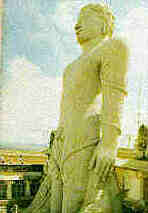 | The Maha-mastak-abhishekha ceremony involves giving a ceremonial bath of to this towering Statue of Bahubali at Shravanabelagola. This ceremony comes once in a few years and is a major event for the Dig-ambara (sky-clad) sect of the Jains. |
Affinity of Jainism with Hinduism
Like the Hindus, the Jains also believe in ages that are defined in terms of morality. Unlike the four ages that are recognised in Hinduism, the Jains recognise only two viz. the Utsarpini or Ascending and the Avasarpini or descending. This connotation of these two ages have a close parallel in the Satyuga and Kaliyuga of the Hindus. Over the ages the Jains have in practice drawn so near to Hinduism as to present outwardly little difference in modes of worship and ritual. The Jains reject the authority of the Vedas but recognize the caste System.
Jainism's Contribution to Hinduism
The Jains like the Hindus (today) practice Moorti Puja (Image Worship). In fact, Moorti Puja is a gift of the Jains to Hinduism. In the Vedic age, Hindus did not practice Moorti Puja. The Gods were the forces of nature who were not personified and they were propitiated through the yagnas.
Later on came the first break in Hinduism, when a section of the Hindus declared that the performing a Yagna sacrifice - where many animals were originally offerred - was an act of apostasy and that the Vedas were not the true embodiment of knowledge. These breakaway Hindus later became the Jains, who for the first time in India (after perhaps the Indus or Saraswati valley civilization) introduced the worship of Images. One instance of such worship is that of the image of the Bahubali who was the son of Rishabha Deva, the first tirthankara. Such Jain shrines with images are found at many places all over India, some of these places are Shravanabelagola, Palitana and Sammed Shikhar.
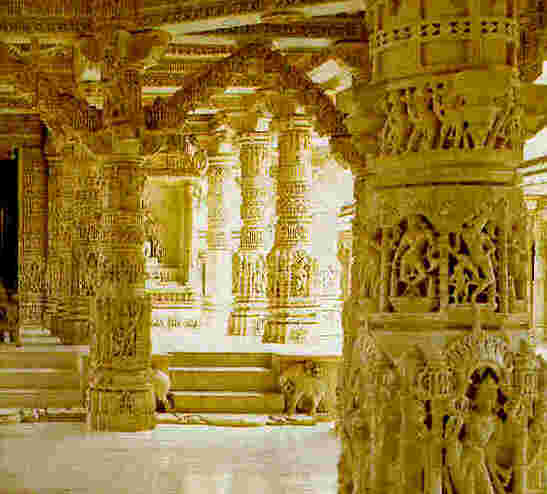 | The Jain temples at Dilwara are among the most magnificent. Seen in this photo is the Vimal Vasahi Temple at Mount Abu. |
This practice of Moorti Puja was absorbed by the rest of the Hindus as their mode of worhip too and later on came the first personified Gods of the Hindus like Brahma-Vishnu-Mahesh and then Sri Rama, Sri Krishna, Shakti, etc. Thus Moorti Poja which was pioneered by the Jain sect, became the most important and far-reaching contribution that the Jains made to Hinduism. This contribution was only second to their other contribution of the concept of Ahimsa and Jivadaya which also the Hindus borrowed from Jainism and Buddhism.
However, though the Jains were the first to split from the Hindu mainstream, nowadays there is observed among the Jains, a sub-conscious tendency to move into Hinduism. Many Jains allow themselves, whether by indifference or set purpose, to be described as Hindus. Though Jainism, like Buddhism arose as a reform movement directed at the then prevailing form of worship that made up Hinduism. It has in modern times shown a stronger tendency for being reabsorbed into the mother faith from which it sprang.
Before , we move ahead, we need to mention here that the difference
between the collection of modes of worship termed Hinduism with that
of the sects which broke away from the Hindu mainstream was that while
within Hinduism, the different Hindu sects recognised all the
dieties of the Hindu pantheon, when selecting one deity
as its patron deity (Ista-Devata), the sects that broke away,
withdrew recognition to the other deities of the Hindu pantheon.
This was the only difference between the various sects within
Hinduism and the sects that broke away from the Hindu mainstream.
 |
Before we proceed with another major religion that originated in India, we shall examine the philosophical schools viz., Vedanta, Sankhya and Lokayata that emerged in ancient India.
_____________________________________________________________
_________________________________________________________________________________
____________________________________
|
|
_ _ _ |
View My Guestbook
|
